Abstract
An investigation of occupational injury was undertaken in a metal smelting industry to examine the occurrence and nature of occupational accidents where analysis of occupational injury records was carried out. At the same time, all the workers were interviewed to collect data in relation to personal and occupational characteristics. With this information, the study aimed to examine the role of different factors in the causation of occupational accidents. High incidence of superficial injuries of limbs due mostly to stepping / striking against objects and overexertion / wrong movements of the workers and the frequent association of handling of small tools with work injuries, observed in this study indicated the role of human error in these accidents and highlighted the necessity of proper safety training of the workers. This study also highlighted the need of elevated safety status during summer months and in evening and night shifts (more so in the second half). Moreover, this study could categorize some high-risk groups e.g. young workers, less-experienced workers, obese workers, workers having smoking / chewing habits etc, who need special attention so far as workplace safety is concerned.
Keywords: Occupational injury, metal smelting, work experience
INTRODUCTION
Metal production tasks are both physically demanding and stressful. The metal workers have been significantly exposed to prolonged hammering and cutting activities in excessive noise and with awkward body postures. Moreover, stressors from heat and humidity, welding fumes and metal dusts often cause excess strain and are reflected in a deterioration of their physical work performance.[1] Such workers frequently suffer from ache or pain in the musculoskeletal system and do have significantly more diagnosed musculoskeletal diseases.[2] Accidental exposure to electricity and magnetic field remains an additional factor affecting human body.[3] Apart from high noise level, poor illumination and a variety of chemical agents, high concentrations of hydrogen fluoride[4] and polycyclic aromatic hydrocarbons (PAH)[5] have been the area of primary concern in such operations. Occupational accidents are another point of major concern in such industrial plants.[6] So far as occupational injuries are concerned, an excess of mortality from accidents (SMR = 1.38) was observed in a mortality study of 6455 French metal plant workers.[7] However, reports on the aspect of injury occurrence in metal smelting operations are scanty. With this background, the present study was undertaken in a metal smelting industry with the following objectives:
To examine the occurrence of accidents by estimating the accidents according to standard ILO procedures
To see the nature of accidents as well as to observe the time trend
To examine the role of different factors like age, job duration, education, marital status, body mass index, nature of work etc. in the causation of occupational accidents
MATERIALS AND METHODS
This study was undertaken in a metal smelting industry where analysis of occupational injury records of five years duration was carried out. At the same time, to collect the personal details of the workers, all the workers who have worked in the set up in the study period of five years (January 2000 - December 2004) were interviewed. Thus, data in relation to age, sex, job, level of education, marital status, habits, experience etc. were collected. A total of 220 workers were interviewed.
Accident registers, pay rolls, productivity registers were examined for the study period of five years to collect data in relation to number of accidents, number of employees, amount of lost man-days and amount of working man-hours. Accident incidence rate, accident frequency rate and accident severity rates were calculated as per the guidelines of ILO.[8] All the rates were calculated for all the five years. Ninety five per cent confidence intervals were calculated[9] for each calculation of accident incidence rate, frequency rate and severity rate. Incidence rate was calculated as number of accidents per thousand exposed workers. Frequency rate was calculated as number of accidents per million working man-hours and severity rate was calculated as number of lost man-days per thousand working man-hours.
To understand the nature of injury and the consequences of it and also to facilitate the understanding of the cascade of events leading ultimately to injury, every single accident was analyzed according to the type of injury, incident that led to accident, body parts involved and agency or equipment involved. Time trend of the accidents was also examined.
In order to estimate the contribution of different possible factors on accident causation, risk calculation was undertaken in relation to every individual factor. Univariate analysis with the help of Ep Info 5 software was done and odds ratios and corresponding 95 % confidence intervals were calculated.
RESULTS
Age wise distribution of workers showed that around 64% of workers were in 30-49 years age range. About 32% subjects were of less than 30 years age and only 4.1% workers were of fifty or more years age. Mean age of the workers was 35.7 ± 7.4 years and mean duration of job was 5.7 ± 1.9 years. So far as body mass index of the workers is concerned, 75.4% were normal whereas 5% and 19.6% workers were having under nutrition and obesity respectively. About sixty five per cent of the subjects were undergraduate while others were educated up to the postgraduate level. Eighty five percent of the workers were married. Forty six percent of the workers had experience of five years or less whereas fifty four percent had more than five years experience. Eighty five percent workers were working in production division and fifteen percent were working in maintenance division. Around twenty nine percent workers were having the habit of smoking / chewing of tobacco-areca nut [Table 1].
Table 1.
Personal and occupational characteristics of workers
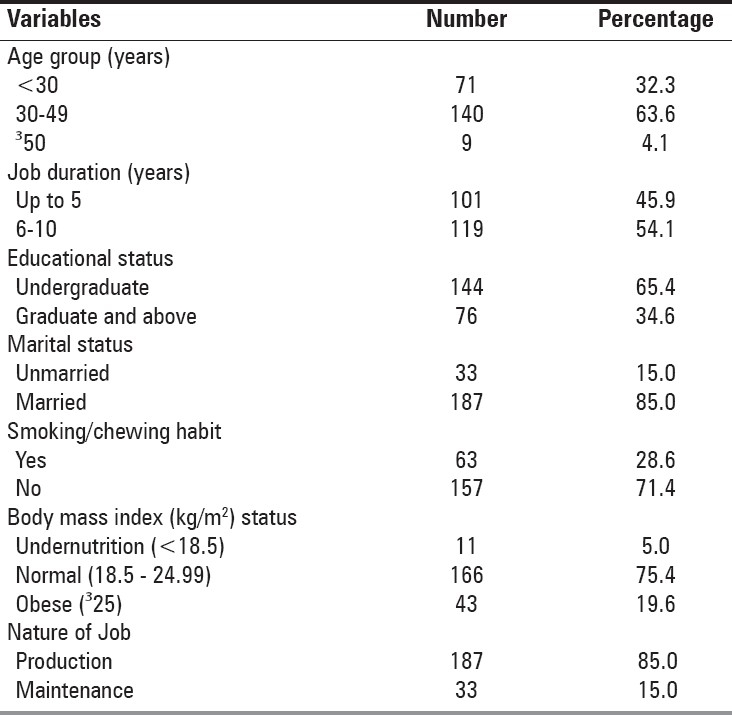
Table 2 describes the distribution of accident incidence, frequency and severity rates over the period of five years. Incidence rate of time loss accidents varies from 40.7 to 85.8 per thousand exposed workers. A decreasing trend was observed in case of time loss accidents except for the year 2004. Similar decreasing trend is also observed in case of distribution of accident frequency rates. Frequency rate for time loss accidents varied from 18.3 to 37.3 per million working man-hours. Severity rate, which is a measure of assessment of harmful effects of occupational accidents on the industry, has varied from 0.19 to 0.34 per thousand working man-hours. A definite trend of decrease was observed in the distribution of severity rate also over a period of first four years.
Table 2.
Distribution of accident statistics of the workers

So far as the number of accidents is concerned, a total of 66 time loss accidents have taken place in the study period of five years. These 66 accidents have involved 62 persons. Four persons had two accidents each and 58 persons had one accident each in the study period of five years.
While observing time trend in the occurrence of injuries it was found that a peak has come into existence in the period of May-June [Figure 1]. The oct temperature during those months) might have played a role for this more frequent occurrences. Similar distribution of accidents accorcurrence of injuries in increased numbers in these months indicates that some environmental factors (increased ambiending to shifts showed that injuries had taken place in increased numbers during the evening and night shifts than during the day shifts [Figure 2]. Time-wise distribution (within the shift) showed increased occurrence in the second half of the working shift [Figure 3].
Figure 1.

Time trend in the occurrence of accidents
Figure 2.
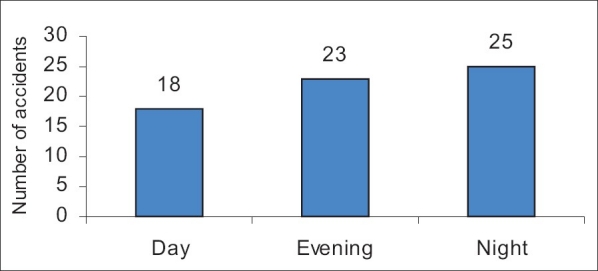
Shift-wise distribution of occurrence of accidents
Figure 3.
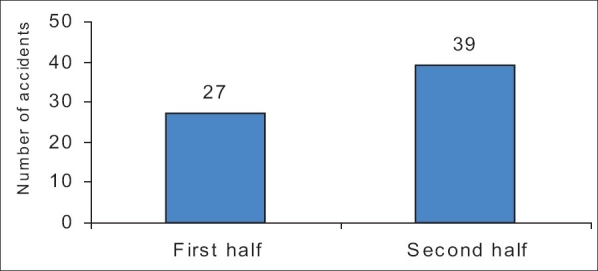
Time-wise (within the shift) distribution of the accidents
On individual analysis of accidents according to body parts involved in accidents, it was found that almost 62% accidents have affected the limbs (upper limb 31.8%, lower limb 30.3%). Head and neck have been affected in almost 20% accidents. Trunk affection was in 9.1% of accidents and multiple locations were involved in 9.1% accidents [Table 3].
Table 3.
Distribution of accidents according to body parts involved in accidents
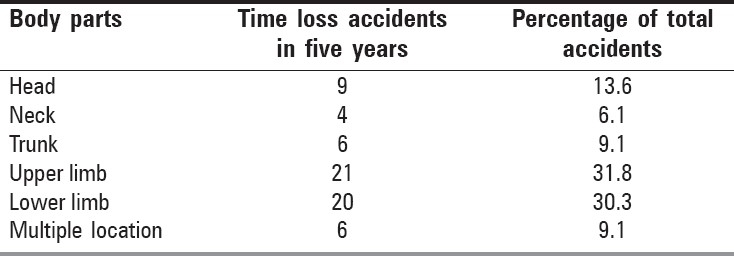
When the accidents were analyzed according to type of injuries [Table 4], it was found that superficial injuries like cuts, abrasions etc. contributed the highest number of injuries (40.9%). Fracture-dislocation and sprain-strain contributed 22.8% and 15.2% respectively of all the accidents. Concussion and Internal injury occurred in 6.1% cases whereas multiple injuries contributed 7.5% of the accidents.
Table 4.
Distribution of accidents according to type of injury
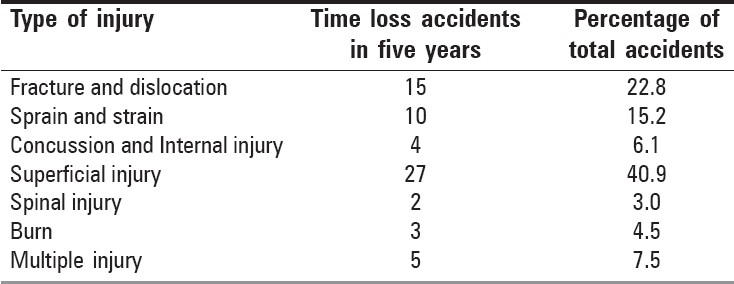
So far as incidents that have occurred during accidents are concerned, the tabulation showed [Table 5] that about 18% accidents each have been caused by fall of a person and fall of an object. Further, 27.3% and 18.2% of accidents are due to stepping / striking against objects and overexertion / wrong movement respectively. Some accidents (13.6%) have occurred when a person was caught in between objects but the major contributor was stepping / striking against objects.
Table 5.
Distribution of accidents according to incidents leading to accidents

On analyzing the accidents in relation to agencies or equipments involved, it was found that tools and machines were the major contributors. Small tools, machines and lifting machines contributed for 36.4%, 28.8% and 10.6% respectively. Workplace environment contributed about 4.5% of total accidents whereas high-risk installations and vehicles contributed for 13.6% and 6.1% accidents respectively [Table 6].
Table 6.
Distribution of accidents according to agency involved in accidents
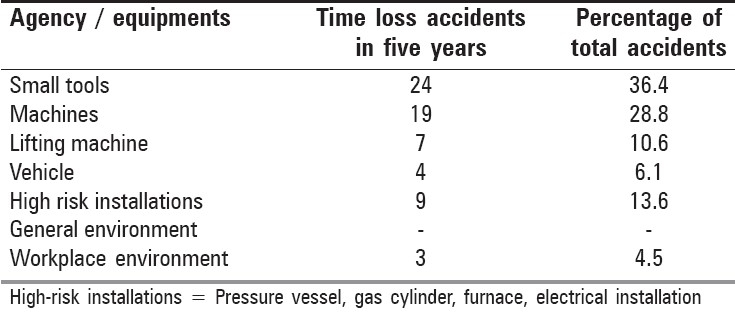
The risk of accident occurrence in relation to different possible factors of accident causation as calculated by univariate analysis is depicted in Table 7. The risk of the factors like age, body mass index, educational status, marital status, personal habit, nature of job etc. was examined. Factors like age < 30 years (OR, 1.47), smoking/chewing habit (OR, 1.24), obesity (OR, 1.70), working in production (OR, 1.27) were found to have increased risk of accident causation though statistically non-significant. Workers having lesser experience (OR, 2.39: 95% CI, 1.25-4.56) were at increased risk (statistically significant) of accident occurrence.
Table 7.
Effect of worker characteristics on injury occurrence (univariate analysis)
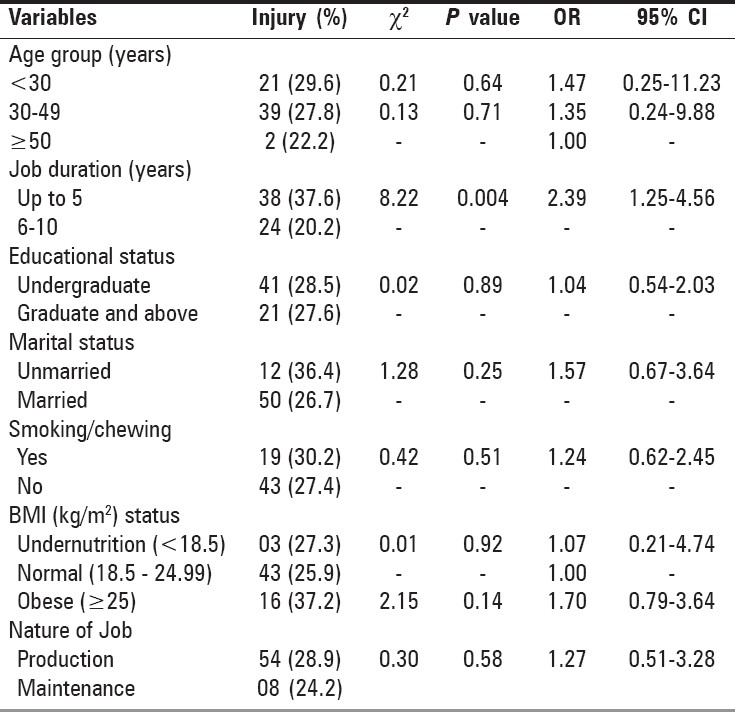
DISCUSSIONS
Non-ferrous and ferrous metal handling, mining, production of petroleum products etc. has remained on the top of the list of occupations where absenteeism (resulting from disability due to occupational injury and disease) has posed a major problem.[10] In this present study, incidence rate of accidents has varied from 40.7 to 85.8 per thousand exposed workers. Frequency rate varied from 18.3 to 37.3 per million working man-hours and severity rate has varied from 0.19 to 0.34 per thousand working man-hours. A decreasing trend was observed in case of the values of the accident parameters except for the year 2004. Probably, with time upliftment of safety measures in metal handling industries is taking place, which is being depicted, in the decreasing trend of values of accident indicators. The occurrence of injuries in increased numbers in the summer months indicates that some factors (increased ambient temperature and humidity during those months) might have played a role for this more frequent occurrence. Accidents have taken place in increased numbers in evening and night shifts and within the shift increased occurrence is observed in the second half of the working shift. It was found that almost 62% accidents have affected the limbs (upper limb 31.8%, lower limb 30.3%), superficial injuries like cuts, abrasions etc. contributed the majority of injuries (40.9%), 45.5% of accidents were due to stepping / striking against objects and overexertion / wrong movements and small tools, machines contributed for 65.2% accidents. So far as factors of injury causation is concerned, age < 30 years, smoking/chewing habit, obesity, working in production were found to have increased risk of accident causation though statistically non-significant. Workers having lesser experience (OR, 2.39: 95% CI, 1.25-4.56) were at increased risk (statistically significant) of accident occurrence.
High incidence of superficial injuries of limbs due mostly to stepping / striking against objects and overexertion / wrong movements of the workers and the frequent association of handling of small tools with work injuries proves the major role of human error in these accidents and indicates the necessity of proper safety training of the workers. This study highlights the need of elevated safety status during summer months and in evening and night shifts (more so in the second half). This study has categorized some high-risk groups e.g. young workers, less-experienced workers, obese workers, workers having smoking / chewing habits etc. These worker groups need special attention so far as workplace safety is concerned. Specific accident-prone jobs / departments have also been identified.
Footnotes
Source of Support: Nil
Conflict of Interest: None declared.
REFERENCES
- 1.Ahasan MR, Mohiuddin G, Vayrynen S, Ironkannas H, Quddus R. Work-related problems in metal handling tasks in Bangladesh: Obstacles to the development of safety and health measures. Ergonomics. 1999;42:385–96. doi: 10.1080/001401399185739. [DOI] [PubMed] [Google Scholar]
- 2.Koskela RS. Mortality, morbidity and health selection among metal workers. Scand J Work Environ Health. 1997;23:1–80. [PubMed] [Google Scholar]
- 3.Nikitina VN, Liashko GG, Nikanov AN, Nikitina NIu. Electromagnetic fields in melting divisions of nickel production. Med Tr Prom Ekol. 2004:39–41. [PubMed] [Google Scholar]
- 4.Doko Jelinic J, Mustajbegovic J, Zuskin E, Lukic J, Cavar V, Ivankovic A. Managing occupational safety and health in aluminum production: Case study of aluminum production factory, Mostar, Bosnia and Herzegovina. Croat Med J. 2005;46:838–47. [PubMed] [Google Scholar]
- 5.Romundstad P, Haldorsen T, Andersen A. Cancer incidence and cause specific mortality among workers in two Norwegian aluminum reduction plants. Am J Ind Med. 2000;37:175–83. doi: 10.1002/(sici)1097-0274(200002)37:2<175::aid-ajim3>3.0.co;2-t. [DOI] [PubMed] [Google Scholar]
- 6.Jovanovic J, Jovanovic M. Occupational accidents and injuries: Results of a safety preventive programme. Arh Hig Rada Toksikol. 2004;55:261–8. [PubMed] [Google Scholar]
- 7.Mur JM, Moulin JJ, Meyer-Bisch C, Massin N, Coulon JP, Loulergue J. Mortality of aluminium reduction plant workers in France. Int J Epidemiol. 1987;16:257–64. doi: 10.1093/ije/16.2.257. [DOI] [PubMed] [Google Scholar]
- 8.Brancoli M. In: International Labour Office. Encyclopaedia of Occupational Health and Safety. 3rd ed. Vol. 1. Geneva: ILO; 1983. Accident Statistics; pp. 32–5. [Google Scholar]
- 9.Anders A, Staffan N. Introduction to modern epidemiology. 2nd ed. USA: Epidemiology Resources Inc; 1990. pp. 73–4. [Google Scholar]
- 10.Szubert Z, Makowiec-Dabrowska T, Sobala W. Health-related absenteeism among workers employed in various work environments. Med Pr. 1999;50:89–118. [PubMed] [Google Scholar]


